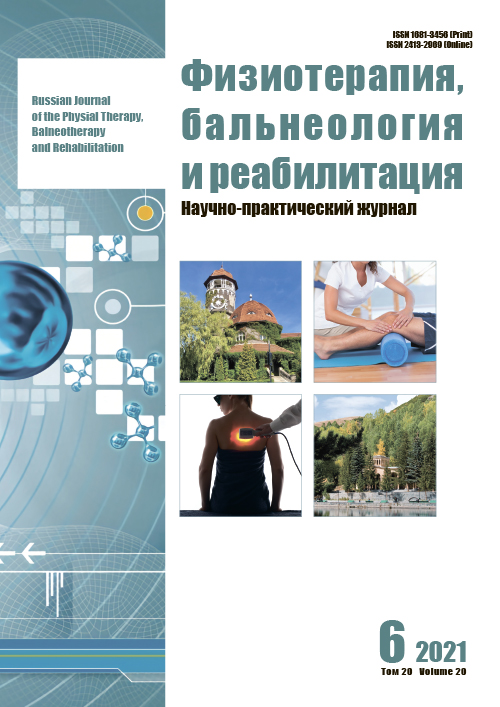Low-frequency magnetotherapy with a running magnetic field of the POLYMAG-02M apparatus in the rehabilitation of patients after COVID-19
- 作者: Larinsky N.E.1, Larinskaya I.K.1,2, Byalovsky Y.Y.3
-
隶属关系:
- Solotcha Sanatorium, Solotcha settlement
- Clinical Hospital of the Medical and Sanitary Unit of the Ministry of Internal Affairs of Russia for the Ryazan Region
- Ryazan State Medical University named after Academician I.P. Pavlov
- 期: 卷 20, 编号 6 (2021)
- 页面: 485-490
- 栏目: Original studies
- ##submission.datePublished##: 15.09.2021
- URL: https://rjpbr.com/1681-3456/article/view/108636
- DOI: https://doi.org/10.17816/rjpbr108636
- ID: 108636
如何引用文章
详细
BACKGROUND: COVID-19 is an infectious viral disease caused by SARS-CoV-2 virus with high morbidity and mortality, especially among the elderly and those with concomitant factors such as diabetes mellitus, chronic lung and heart disease. For patients who have undergone coronavirus pneumonia, given the severity of the disease, rehabilitation measures are needed to restore the consequences of the disease.
AIMS: To evaluate the effectiveness of the use of low-frequency magnetic therapy with a running magnetic field in the complex of rehabilitation treatment of patients who have undergone pneumonia caused by SARS-CoV-2 (COVID-19) at the stage of convalescence.
MATERIAL AND METHODS: Examination and treatment of 42 patients (24 men and 18 women) aged 40 to 65 years, who had community-acquired pneumonia (J16.8) caused by the new coronavirus SARS-CoV-2 (COVID-19), were carried out. The first (main) group of patients included 22 people who underwent physical therapy, aeroinotherapy, low-frequency oscillatory massage of the chest in an electrostatic field, intravenous laser blood irradiation, high-frequency oscillation of the chest and carbon dioxide baths. Against this background, starting from the 20th day after discharge from the hospital, this group of patients received low-frequency, low-intensity magnetotherapy from the POLIMAG-02M apparatus. The second (control group) included 20 patients who received the same treatment, except for magnetotherapy from the POLIMAG-02M apparatus.
RESULTS: The course of rehabilitation treatment led to an increase in the functional capabilities of the cardio-respiratory system in patients of both groups, an increase in chest excursions, an increase in the vital capacity of the lungs, the normalization of the act of breathing and ventilation of the lungs, and an improvement in the psychosomatic status of patients. In the main group, these changes are more pronounced than in the control group, which is associated with the inclusion of low-frequency magnetotherapy with a running magnetic field in the complex treatment.
CONCLUSION: The use of low-frequency magnetic therapy with a running pulsed magnetic field in the complex of rehabilitation measures for patients who have undergone pneumonia caused by the COVID-19 virus significantly improves the somatic status of patients, increases exercise tolerance, and optimizes the function of external respiration. The data obtained make it possible to recommend the inclusion of the factor in clinical guidelines for the rehabilitation of patients who have undergone COVID-19.
全文:
作者简介
Nikolay Larinsky
Solotcha Sanatorium, Solotcha settlement
Email: nlarinsky@mail.ru
ORCID iD: 0000-0002-9294-3932
SPIN 代码: 8198-6732
MD, Cand. Sci. (Med.)
俄罗斯联邦, RyazanIrina Larinskaya
Solotcha Sanatorium, Solotcha settlement; Clinical Hospital of the Medical and Sanitary Unit of the Ministry of Internal Affairs of Russia for the Ryazan Region
Email: nlarinsky@mail.ru
ORCID iD: 0000-0002-8023-2412
SPIN 代码: 8704-7121
MD
俄罗斯联邦, Ryazan; RyazanYuriy Byalovsky
Ryazan State Medical University named after Academician I.P. Pavlov
编辑信件的主要联系方式.
Email: b_uu2610@mail.ru
ORCID iD: 0000-0002-6769-8277
SPIN 代码: 6389-6643
Scopus 作者 ID: 8539156800
Researcher ID: E-1192-2014
MD, Dr. Sci. (Med.), Professor
俄罗斯联邦, Ryazan参考
- Avdeev SN, Vasilyeva OS, Chuchalin AG. Respiratory medicine: a guide. 2nd ed. Chuchalin A.G., editor. Moscow: LitTerra; 2017. Vol. 3. 462 p. (In Russ).
- Ivanova GE, Shmonin AA, Maltseva MN, et al. Rehabilitation care during the new COVID-19 coronavirus infection epidemic at first, second and third medical rehabilitation phases. Physical and rehabilitation medicine, medical rehabilitation. 2020;2(2):98–117. (In Russ). doi: 10.36425/rehab34148
- Klyachkin LM, Malyavin AG, Ponomarenko GN, et al. Physical methods of treatment in pulmonology. Saint Petersburg: SLP; 1997. 316 p. (In Russ).
- Zilber AP. Respiratory medicine. Petrozavodsk: PGU, 1996. 488 p. (In Russ).
- Ponomarenko GN, Ulashchik VS. Physical therapy: molecular foundations. Saint Petersburg: Chelovek; 2014. 288 p. (In Russ).
- Abramovich SG, Adilov VV, Antipenko PV, et al. Physical therapy: national guidelines. Ponomarenko GN, editor. Moscow: GEOTAR-Media, 2009. 864 p. (In Russ).
- Gerasimenko MYu, Konchugova TV, Kulchitskaya DB, et al. Magnetotherapy in treatment, rehabilitation and prevention programs: clinical guidelines. Moscow; 2015. 47 p. (In Russ).
- Struchkov PV, Vinitskaya RS, Lyukevich IA. Introduction to functional diagnostics of external respiration. Moscow: Transservis; 1996. 72 p. (In Russ).
补充文件






